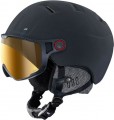Sizes in which this helmet model is available.
A suitable size is determined primarily by the circumference of the head at its widest point, at the level of a couple of centimetres above the eyebrows. Sizes are indicated everywhere as standard —
XXS,
XS,
S,
M,
L,
XL,
XXL, etc. However, these designations may correspond to different actual helmet sizes for different manufacturers. For example, size S for one brand may be designed for a head circumference of 56 cm, and another — for 52 – 54 cm. In addition, men's and women's helmets (see "Gender and age") of the same size may also differ. Therefore, to select a helmet that is suitable for head circumference, it is best to use special tables that take into account the points described above.
Also, note that helmets of the same size can differ markedly in internal shape and other features. Therefore, when choosing, you need to take into account not only the size, but also the actual convenience — the helmet should sit tightly on the head, but not compress it.
The presence of
a detachable lining in the helmet design.
The detachable lining practically does not affect the functionality and protective properties of the helmet — except that for “extreme” professional models it is considered poorly suitable, because does not provide the required high level of protection. At the same time, this feature makes it much easier to maintain the equipment: the detachable lining can be periodically washed in a regular washing machine, and it is much easier to wash/clean it by hand than a non-detachable one.
The presence of
detachable ear pads in the helmet design.
This feature is found mainly in helmets for snowboarding. When snowboarding, good visibility and audibility are important; therefore, the shell of such helmets (unlike classic ski helmets) does not cover the ears, and the role of ear protection is played by pads, which are an extension of the balaclava. These pads can be made detachable — for example, for riding in relatively warm weather, or in case you need to hear as well as possible and keep your ears completely open.
Note that soft pads protect the ears primarily from the cold. The degree of impact protection for helmets of this design is noticeably lower than in models with a solid shell that covers, among other things, the athlete's ears. Therefore, helmets with this feature are recommended either for simple riding conditions or for those cases where good audibility is fundamentally more important than an increased degree of protection.

